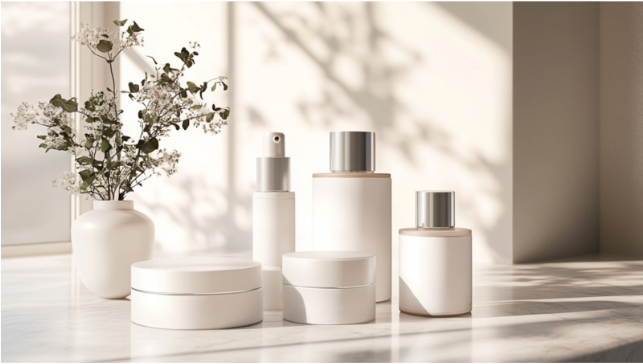Creating a basic skincare routine that matches your needs can transform your skin’s looks and feels. The key is knowing which products to use and the proper order to use them. Although different skin types need different care, you can handle acne, dryness, and irritation using the right approach. This guide walks you through each step toward clear, glowing skin.

Why a Basic Skincare Routine Is Key to Clearer Skin
A basic skincare routine is essential for clear skin. With the right steps, you can effectively tackle acne, dryness, and irritation. It’s not about expensive products but about sticking to the basics that work. Let’s explore why this approach is key to achieving clearer skin:
Step 1: Cleansing
Cleansing is the foundation of any skincare routine because it removes dirt, oil, and impurities that cause breakouts. To keep skin fresh, wash your face with lukewarm water twice daily—once in the morning and before bed. This simple step prepares your skin for the rest of your routine. Now, let’s talk about how to pick the right cleanser for your skin type.
- Oily Skin: Use a foaming or gel cleanser to remove excess oil without stripping your skin of its natural moisture.
- Dry Skin: To hydrate your skin, use a moisturizing cleanser with ingredients like hyaluronic acid or glycerin.
- Sensitive Skin: To protect your sensitive skin from irritation, use a mild, fragrance-free cleanser.
Step 2: Exfoliating
Exfoliating removes dead skin cells, helps renew your skin, and clears your pores. However, it’s important to exfoliate properly to prevent irritation:
- Physical Exfoliants: Use scrubs with tiny grains 1-2 times a week, depending on your skin sensitivity.
- Chemical Exfoliants: Apply products with AHAs or BHAs 2-3 times weekly. BHAs, like salicylic acid, work well for acne-prone skin by cleaning deep into the pores.
Step 3: Toning
Toners help balance your skin’s pH, clean up any leftover dirt, and prepare your skin for the next steps in your routine. You can either apply toner with a cotton pad or pat it on. Here’s a simple guide to picking the right toner for your skin type:
- Oily/Acne-Prone Skin: To help control oil and acne, look for toners with salicylic acid, witch hazel, or tea tree oil.
- Dry/Sensitive Skin: To hydrate and soothe your skin, use toners containing rose water or aloe vera.
Step 4: Treatment Serums
Serums are concentrated treatments that target specific skin concerns. After toning, apply the serum and allow it to absorb fully before moving on to the next step. Moreover, they contain active ingredients that make a significantly positive difference in your skin’s health:
Acne
Serums with benzoyl peroxide, salicylic acid, or niacinamide can reduce breakouts and inflammation. These ingredients work to unclog pores, which helps prevent new pimples from forming. Additionally, they calm irritated skin, which leads to a clearer complexion.
Hyperpigmentation
Vitamin C serums can brighten your skin and fade dark spots. This powerful antioxidant not only evens out skin tone but also protects against future sun damage. Over time, you’ll likely notice that dark patches diminish, which results in a more even skin tone.
Aging
Look for serums with retinol or peptides to boost collagen production and reduce fine lines. Retinol is particularly effective because it speeds up cell turnover, which reveals fresher skin beneath. Meanwhile, peptides support the skin’s structure and promote collagen. Together, they help keep your skin firm and smooth and address wrinkles and fine lines.
Step 5: Moisturizing
Moisturizing is essential for all skin types, even oily and acne-prone skin. Therefore, apply your moisturizer twice daily to keep your skin supple and hydrated. As a result, the right moisturizer can help maintain your skin’s hydration levels and protect the skin barrier.
- Oily Skin: Lightweight, non-comedogenic moisturizers that won’t clog pores are ideal.
- Dry Skin: Rich, creamy moisturizers with ingredients like shea butter or ceramides provide intense hydration.
- Combination Skin: Gel-based moisturizers can provide hydration without feeling greasy.
Step 6: Sun Protection
Protecting your skin from the sun’s UV rays is crucial to avoid early aging, dark spots, and skin cancer. Consequently, use a broad-spectrum sunscreen with at least SPF 30 daily. If you tend to get acne, choose a non-comedogenic sunscreen to avoid clogging your pores.
Additional Tips for an Effective Basic Skincare Routine
- Consistency is Key: Stick to your routine daily to see the best results.
- Test New Products: Before introducing a new product, patch-test it on a small area of your skin to ensure it doesn’t irritate.
- Adjust Based on Seasons: Your skin’s needs can change with the seasons. For example, you might need a heavier moisturizer in the winter and a lighter one in the summer.
- Listen to Your Skin: Pay attention to how your skin responds to different products and tweak your routine as needed.
Stick to this basic skincare routine to help control acne and get a clearer, healthier complexion. In short, stay consistent, choose products that suit your skin type, and listen to its needs. Make adjustments when necessary, and give your skin the attention it deserves.
Are you ready to improve your skincare? Learn more expert tips and tricks on creating an effective skincare routine. Explore now and give your skin the care it craves!